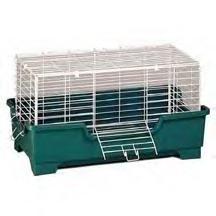The Basics of Hedgehog Care
Housing
The first thing you need for your hedgehog is a cage. The cage will be where the hedgehog spends most of his time, so make sure it is comfortable. A metal or plastic cage (like those made for guinea pigs or ferrets) works great, or a 20 gallon or larger aquarium. I have also heard that a large, clear, plastic tub works well too. Just drill some holes in the top for ventilation. Make sure that the cage has at least 2 square feet of floor space, and that the cage bottom has no wire grates that little hedgehog feet can fall through and get hurt on. If it does have a wire bottom, cover it with vinyl, etc. Clean the cage at least once a week, and odor won't be a problem.
|
 |
Hiding Place
Provide a hiding place or cover for the hedgehog to hide under, so that it will be less nervous. Large "critter logs," a shoe box or kleenex box with a side cut out work fine. Make sure the hole is big enough so your hedgie won't get stuck!
|
|
Temperature
You will want to keep the housing in a warm area of the house. Hedgehogs are from a warm environment and need to stay warm, but not too hot (about 68F to 85F is usually a good range). Heating pads can work well in the winter, but make sure that the pad is not under the entire cage so that if your hedgehog starts to overheat, it can move to a cooler spot.
|
|
Bedding
Add a one to two inch layer of pine, aspen, ground corn cob, or other small animal bedding to your hedgehog's home. Don't use cedar because the oils can cause respiratory illness or death in hedgehogs (and many other small animals). There reallyis no such thing as a perfect hedgehog bedding, so you may want to experiment. Some people report great results with astroturf, which they remove to wash on a daily or every-other day basis, and plain newsprint has been used with satisfaction, too.
|
|
Toys
Hedgehogs need lots of exercise, as they tend to become obese with inactivity. A large wheel (11" diameter or so) is recommended. Be sure that the running surface of the wheel is solid, so that the hedgie is not at risk for slipping and breaking legs. Try putting a cast on a teeny tiny hedgehog leg!
Most hedgies are pretty curious and love toys they can push, chew, or manipulate. Some things ours they might enjoy include solid rubber balls, small toy cars, large plastic toy trucks, toilet paper tubes, and rawhide chews. Be creative, but always try to think safe.
|
|
Diet
Low-calorie dry cat food with some fruits and vegetables should be the mainstay of your hedgehog's diet. The cat food should be a high-quality brand such as Eukanuba or Science Diet, which provides nearly the appropriate amount of protein (30 to 50 percent) without too much fat (not more than 20 percent). This also will allow your hedgie to get the right amount of calcium. You may also want to give your hedgehogs little treats every now and then such as crickets and mealworms.
|
|
Handeling
The more you handle your hedgehog, the more it will get used to you is a good rule of thumb to remember.
At first, your hedgehog may be scared. It may ball up or puff air and click its tongue to scare away any potential predator (you). Approach your hedgehog slowly and quietly to gain its trust. Pick up your hedgehog from underneath to avoid the quills. You shouldn't need gloves to pick it up, even if it is scared, since you can slide your fingers underneath to distribute the weight. Try not to wear gloves so the hedgehog can associate your smell with being picked up.
|
|
|
|